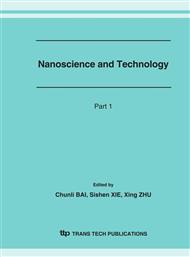p.219
p.223
p.227
p.231
p.235
p.239
p.243
p.247
p.251
The Orthogonal Optimization of Process Parameters of Silica Xerogels
Abstract:
Two-step acid-base catalyzed silica xerogels were prepared through sol-gel and ambient pressure drying. Various additive components were main fators which influenced the porosity of silica xerogles. An orthogonal array (OA) design OA9(34) was applied to select the optimum conditions of additives. The effects of the molar ratio of H2O, alcohol, HCl, and ammonia were evaluated on the basis of the other same process parameters. Every experiment was conducted several times under different process conditions which included reactive temperature, the acid catalyzed time, aging, exchanging solvent and drying for assuring gels formed. The porosity was an index which was used to appraise the characteristic of silica xerogels. Two kinds of silica xerogels, prepared by the most optimal molar ratio (OMR) and the best OA experiment respectively, were compared by means of SEM. The results showed that the most OMR of TEOS, H2O, alcohol, HCl and ammonia was 1:4:10:7.5× 10-4:0.0375.
Info:
Periodical:
Pages:
235-238
Citation:
Online since:
March 2007
Authors:
Price:
Сopyright:
© 2007 Trans Tech Publications Ltd. All Rights Reserved
Share:
Citation:


